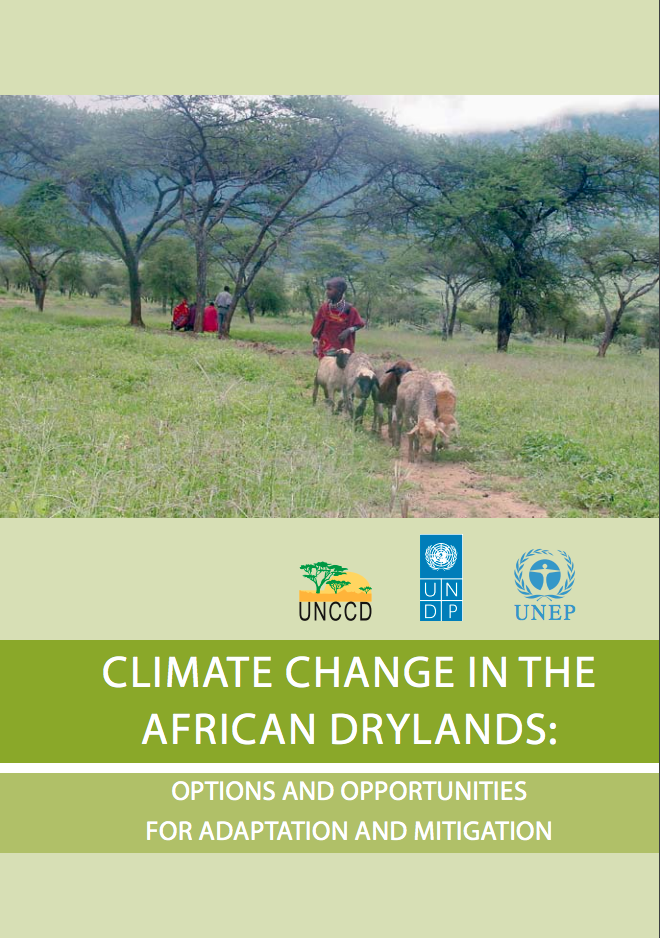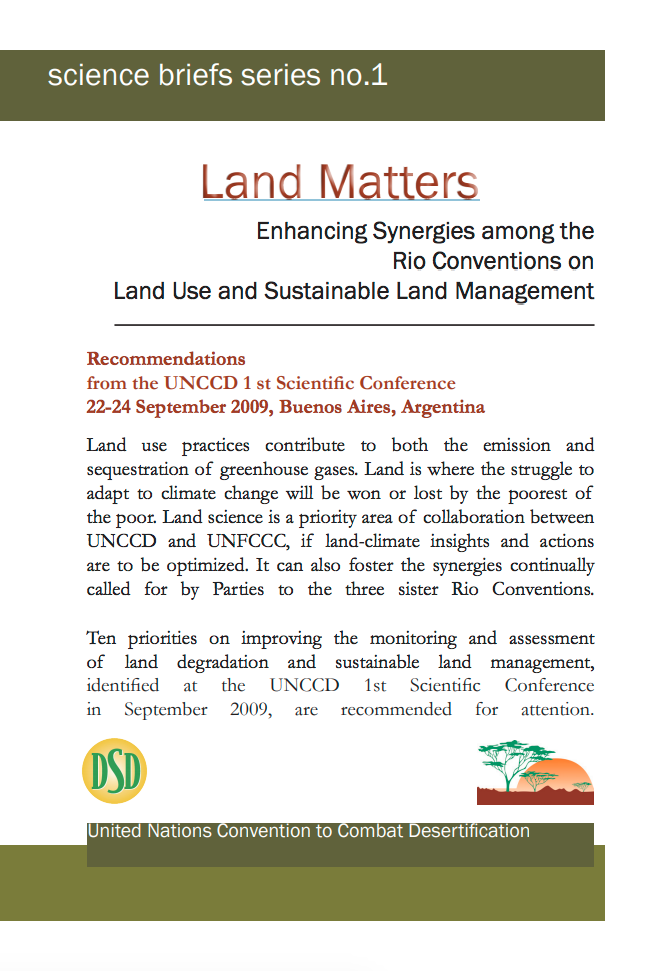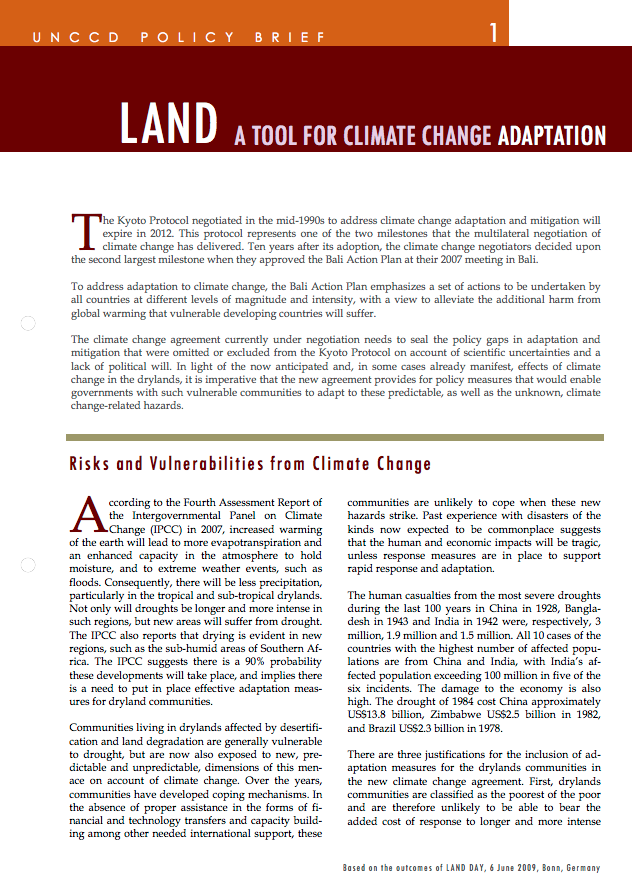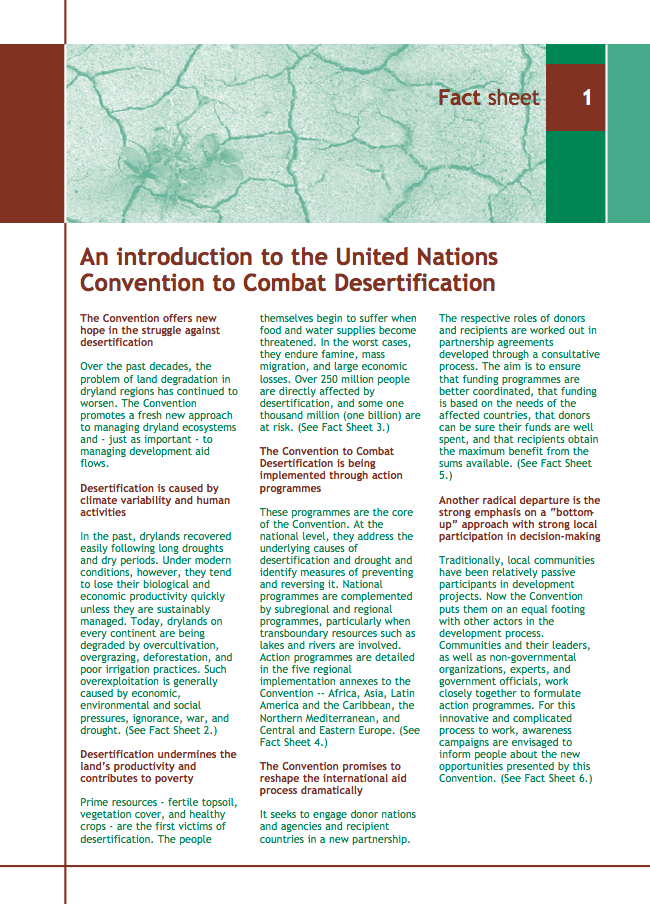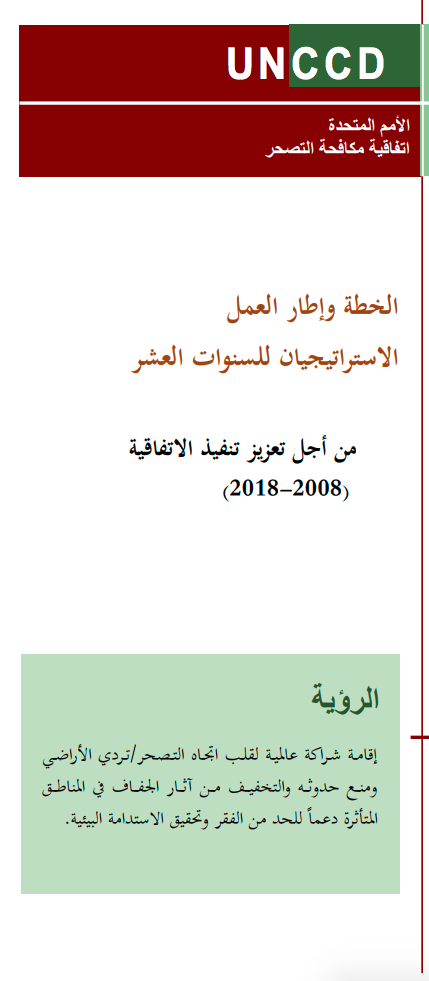Details
Location
Contributions
Displaying 291 - 300 of 2403Climate change in the African drylands: Options and opportunities for adaptation and mitigation
The drylands of Africa, exclusive of hyper-arid zones, occupy about 43 per cent of the continent, and are home to a rapidly growing population that currently stands at about 325 million people. Dry zones, inclusive of hyper-arid lands, cover over 70 per cent of the continent’s terrestrial surface. Outside of the cities many dryland inhabitants are either pastoralists, sedentary or nomadic, or agro-pastoralists, combining livestock-rearing and crop production where conditions allow.
Land Matters: Enhancing Synergies among the Rio Conventions on Land Use and Sustainable Land Management
Land use practices contribute to both the emission and sequestration of greenhouse gases. Land is where the struggle to adapt to climate change will be won or lost by the poorest of the poor. Land science is a priority area of collaboration between UNCCD and UNFCCC, if land-climate insights and actions are to be optimized. It can also foster the synergies continually called for by Parties to the three sister Rio Conventions.
Way Forward After CST 9
Until now, the international community has made tireless efforts to get public attention and political action on issues of desertification, land degradation and drought (DLDD) with limited success.
Thus, the mobilization of political will and arousal of public interest and attention around the issue of climate change in particular puzzled activists and decision-makers alike, at least in the DLDD community.
Mitigating Climate Change in Drylands – The Case for Financing Carbon Sequestration
Drylands have the potential to play a big role in climate mitigation and, in doing so, to deliver significant co-benefits
Land: a tool for climate change mitigation
The Kyoto Protocol negotiated in the mid-1990s to address climate change adaptation and mitigation will be replaced by a post-Kyoto agreement in 2012. The new agreement under negotiation needs to seal the policy gaps in adaptation and mitigation that were omitted or excluded from Kyoto on account of scientific uncertainties. Particular attention needs to be given to the potential of land in all its dimensions considering its high capacity to store carbon. Land stores twice as much organic carbon as vegetation and the atmosphere combined.
Land: a tool for climate change adaptation
The Kyoto Protocol negotiated in the mid-1990s to address climate change adaptation and mitigation will expire in 2012. This protocol represents one of the two milestones that the multilateral negotiation of climate change has delivered. Ten years after its adoption, the climate change negotiators decided upon the second largest milestone when they approved the Bali Action Plan at their 2007 meeting in Bali.
UNCCD Ficha informativa: Introducción a la Convención de las Naciones Unidas de Lucha contra la Desertificación
La Convención ofrece nuevas esperanzas para luchar contra la desertificación
En las últimas décadas el problema de la degradación de tierras en las regiones de zonas secas ha seguido empeorando. La Convención promueve un nuevo método para gestionar los ecosistemas de tierras secas y administrar las aportaciones de ayuda al desarrollo.
UNNCD Fiche d’information: Introduction à la Convention des Nations Unies sur la lutte contre la désertification
La Convention offre de nouveaux espoirs dans la lutte contre la désertification
Le problème de la dégradation des terres dans les régions arides n'a cessé de s'aggraver au cours des vingt dernières années décennies. La Convention propose une manière entièrement nouvelle de gérer les écosystèmes arides et -ce qui n'est pas moins important- les flux d'aide au développement.
UNCCD Factsheet: An introduction to the United Nations Convention to Combat Desertification
The Convention offers new hope in the struggle against desertification Over the past decades, the problem of land degradation in dryland regions has continued to worsen. The Convention promotes a fresh new approach to managing dryland ecosystems and - just as important - to managing development aid flows.
The 10-year strategic plan and framework to enhance the implementation of the Convention (2008–2018) (Arabic)
THE VISION to forge a global partnership to reverse and prevent desertification/land degradation and to mitigate the effects of drought in affected areas in order to support poverty reduction and environmental sustainability


